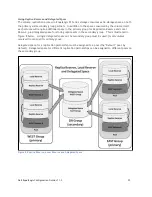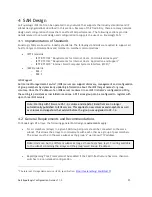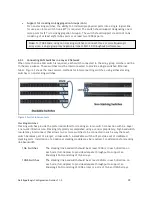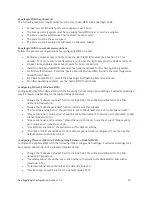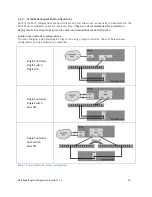
Dell EqualLogic Configuration Guide v11.3
27
4.3
Ethernet Switches and Infrastructure
An EqualLogic SAN consists of one or more hosts connected to one or more PS Series arrays through a
switched Ethernet network. To support a high performance Dell EqualLogic SAN, switches must meet
the following general requirements:
Low latency
Switches with relatively high latency may cause SAN throughput performance to degrade, and
under high load conditions they could increase the risk of dropped connections.
Non-blocking backplane design
SAN Switches should be able to provide the same amount of backplane bandwidth to support
full duplex communication on ALL ports simultaneously.
Adequate buffer space per switch port
In addition to supporting data transfers between the hosts and the SAN, Dell EqualLogic arrays
also use the SAN to support inter-array communication and data load balancing. For this
reason, the more buffer space per port that a switch can provide the better. Due to the
multitude of buffer implementations used by switch vendors, Dell cannot provide definitive
guidelines as to how much is enough, but as a general guideline switches should have at least
256KB per port. Port buffers should be designed such that data is not lost when traffic reaches
extreme levels.
Support for IEEE 802.3x flow control (passive and/or active) on ALL ports.
Switches and network interface controllers used in an EqualLogic SAN must be able to passively
respond to any ―pause‖ frames received. If possible, you should use switches that have the
ability to transmit ―pause‖ frames to external devices in the event that the device cannot
adequately forward traffic in a timely fashion.
Support for Jumbo Frames
This is not a requirement. But, the use of jumbo frames may yield desirable results. Most iSCSI
SAN implementations should benefit from using jumbo frames. The actual impact on SAN
throughput when using jumbo frames will depend on your workload’s I/O characteristics.
Support for Rapid Spanning Tree protocol (IEEE 802.1w), or Cisco “portfast” functionality
if
the SAN infrastructure will consist of more than two switches
For SAN infrastructures consisting of more than 2 non-stacking switches, R-STP must be enabled
on all ports used for inter-switch trunks. All non-inter-switch trunk ports should be marked as
―edge‖ ports or set to ―portfast‖.
Support for unicast storm control
iSCSI in general, and Dell EqualLogic SANs in particular can send packets in a very ―bursty‖
profile that many switches could misdiagnose as a virally induced packet storm. Since the SAN
should be isolated from general Ethernet traffic, the possibility of actual viral packet storms
occurring is non-existent. In an EqualLogic SAN, the switches must always pass Ethernet
packets regardless of traffic patterns.
Support for Inter-Switch Trunking (IST) or Stacking
IST support is required to link all switches in SAN infrastructure together. For stacking capable
switches, the use of stacking ports for IST is assumed. A good rule of thumb for stacking link
bandwidth would be a minimum 20 Gbps full-duplex.
Support for vLAN functionality if SAN traffic is to share the same physical switch resources
with other (non-iSCSI SAN) network traffic.
Summary of Contents for EqualLogic PS4000
Page 1: ...Dell EqualLogic Configuration Guide Dell EqualLogic Storage Infrastructure and Solutions ...
Page 11: ...Dell EqualLogic Configuration Guide v11 3 6 Figure 1 Partially Connected Controller Failover ...
Page 44: ...Dell EqualLogic Configuration Guide v11 3 39 Figure 14 Mixed Speed Redundant SAN ...











